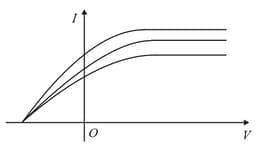Exercise
Embibe Experts Physics Solutions for Exercise
Simple step-by-step solutions to Exercise questions of DUAL NATURE OF RADIATION AND MATTER from Physics Crash Course (Based on Revised Syllabus - 2023). Also get 3D topic explainers, cheat sheets, and unlimited doubts solving on EMBIBE.
Questions from Exercise with Hints & Solutions
Every metal has a definite work function. Why do all photoelectrons not come out with the same energy if incident radiation is monochromatic? Why is there an energy distribution of photoelectrons?
In an experiment on the photoelectric effect, the following graphs were obtained between the photoelectric current (I) and the anode potential (V). Name the characteristic of the incident radiation that was kept constant in this experiment.

Crystal diffraction experiments can be performed using X-rays, or electrons accelerated through appropriate voltage. Which probe has greater energy? (For quantitative comparison, take the wavelength of the probe equal to , which is of the order of inter-atomic spacing in the lattice) ().
Compute the typical de Broglie wavelength of an electron in a metal at and compare it with the mean separation between two electrons in a metal which is given to be about .
Light of wavelength is produced by an argon laser which is used in the photoelectric effect. When light from this spectral line is incident on the emitter, the stopping (cut-off) potential of photoelectrons is . Find the work function of the material from which the emitter is made.
What is the
(a) momentum,
(b) speed, and
(c) de Broglie wavelength of an electron with kinetic energy of .
Identify the process in which an electron escapes from the metal surface.
If the de Broglie wavelength of a particle of mass is times its velocity, then its value in terms of its mass () and Planck's constant () is
